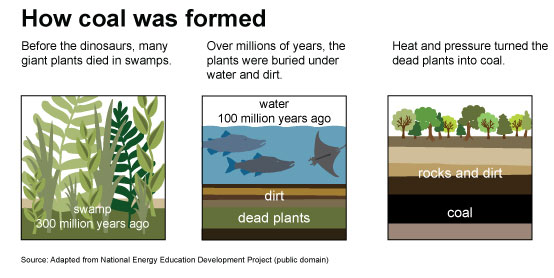Coal takes millions of years to form
Coal is a combustible black or brownish-black sedimentary rock with a high amount of carbon and hydrocarbons. Coal is classified as a nonrenewable energy source because it takes millions of years to form. Coal contains the energy stored by plants that lived hundreds of millions of years ago in swampy forests.
Layers of dirt and rock covered the plants over millions of years. The resulting pressure and heat turned the plants into the substance we call coal.
Types of coal
Coal is classified into four main types, or ranks: anthracite, bituminous, subbituminous, and lignite. The ranking depends on the types and amounts of carbon the coal contains and on the amount of heat energy the coal can produce. The rank of a coal deposit is determined by the amount of pressure and heat that acted on the plants over time.
Anthracite contains 86%–97% carbon and generally has the highest heating value of all ranks of coal. Anthracite accounted for less than 1% of the coal mined in the United States in 2022. All anthracite mines in the United States are in northeastern Pennsylvania. In the United States, anthracite is mainly used by the metals industry.
Bituminous coal contains 45%–86% carbon. Bituminous coal in the United States is between 100 million and 300 million years old. Bituminous coal is the most abundant rank of coal found in the United States, and it accounted for about 46% of total U.S. coal production in 2022. Bituminous coal is used to generate electricity and is an important fuel and raw material for making coking coal for the iron and steel industry. Bituminous coal was produced in at least 16 states in 2022, but five states accounted for about 78% of total bituminous production. The top five bituminous producing states and their percentage share of total U.S. bituminous production in 2022 were:
- West Virginia—31%
- Illinois—14%
- Pennsylvania—14%
- Kentucky—11%
- Indiana—9%
Subbituminous coal typically contains 35%–45% carbon, and it has a lower heating value than bituminous coal. Most subbituminous coal in the United States is at least 100 million years old. In 2022, subbituminous coal accounted for about 46% of total U.S. coal production. The five subbituminous producing states and their percentage share of total U.S. subbituminous production in 2022 were:
- Wyoming—89%
- Montana—8%
- New Mexico—2%
- Colorado—2%
- Alaska—<1%
Lignite contains 25%–35% carbon and has the lowest energy content of all coal ranks. Lignite coal deposits tend to be relatively young and were not subjected to extreme heat or pressure. Lignite is crumbly and has high moisture content, which contributes to its low heating value. In 2022, five states produced lignite, which accounted for 8% of total U.S. coal production. The five lignite-producing states and their percentage share of total U.S. lignite production in 2022 were:
- North Dakota—56%
- Texas—36%
- Mississippi—7%
- Louisiana—1%
- Montana—<1%
The Great Plains Synfuels Plant in North Dakota converts lignite to synthetic natural gas that is sent in natural gas pipelines to consumers in the eastern United States.
Last updated: October 24, 2023, with data available at the time of update.

